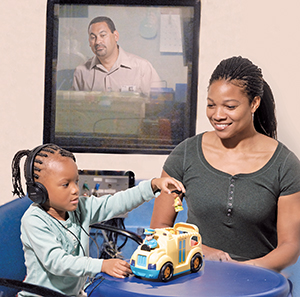Hearing Tests for Infants and Children
Hearing Tests for Infants and Children

Auditory brainstem response audiometry (ABR)
Also called brainstem auditory evoked response (BAER) or brainstem auditory evoked potentials (BAEP).
What does the test measure?
Records brainwaves and how well sound signals travel along the hearing nerve to the brain. It helps predict how well the inner ear and brainstem are working with regard to hearing.
How is the test done?
A child may be sleeping or sedated.
Electrodes on sticky pads are placed in or behind the child’s ears and on the head. The electrodes record how the brain responds to different sounds. These sounds travel through earphones or headphones, which are placed inside or over the child’s ears.
The test takes 30 to 60 minutes.
Otoacoustic emissions (OAE)
What does the test measure?
Tests the function of the inner ear. Sound is sent into the ear canal and the response of the inner ear is measured. The test helps determine whether there is a problem and if further testing is needed.
How is the test done?
The child needs to be asleep or sitting quietly.
Sound is sent into the ear canal through a probe (small, thin medical instrument with a rubber tip) that sends and records sound. The ear’s response to sound is measured.
OAE tests for fluid, blockage, or any damage to portions of the ear.
The test takes a few minutes.
Acoustic immittance testing
There are 2 kinds of acoustic immittance tests: tympanometry and acoustic reflex testing.
What do the tests measure?
Tests how the middle ear responds to sound or pressure. The tests help find problems with the middle ear that may cause trouble hearing.
How are the tests done?
A probe is put into the ear canal.
For tympanometry, the instrument gently pushes air in and pulls air out of the ear canal. The changes in air pressure move the eardrum. The movement of the eardrum is measured.
For acoustic reflex testing, sound is sent into the ear canal. The reaction of the muscles in the middle ear to sound is measured. This test gives information about the type and location of the hearing problem
The test takes a few minutes.
Behavioral observation audiometry
What does the test measure?
Tests the response to sounds. It helps the audiologist rule out major hearing loss. The test can be done with children from birth to 4 months.
How is the test done?
A sound is made by talking or with a special noisemaker. The audiologist evaluates the child’s response to the sound. This may include head turning, quieting, startling, or eye widening.
Visual reinforcement audiometry
What does the test measure?
Tests the response to sounds. It determines the softest sound your child can hear. The test can be done with children ages 6 months to 3 years old.
How is the test done?
A sound is played for the child. Upon hearing the sound, the child is taught to turn toward the source of the sound. Then a toy or video screen lights up. The child’s eye and head movements are evaluated.
Conditioned play audiometry
What does the test measure?
Tests the response to sounds. It determines the softest sound the child can hear. The test can be done with children ages 2 years to 4 years old who can follow instructions.
How is the test done?
The child performs a task, such as throwing a ball into a bucket, each time a sound is heard. The child’s response to sounds is evaluated.
Conventional screening audiometry
What does the test measure?
Tests for hearing problems. The test can be done with children age 4 years or older.
How is the test done?
The child wears headphones and listens for different sounds. The child then raises his or her hand when a sound is heard.
Tips to prepare your child for hearing tests
Help prepare your child for his or her hearing test by doing the following:
If you have earphones or headphones, let your child listen to quiet music through them to get him or her used to using them.
Reassure your child that hearing tests are painless and there are no shots involved.
Tell your child that he or she gets to play games during the test.
Updated:
October 10, 2017
Sources:
Hearing impairment in children: Evaluation, Up To Date
Reviewed By:
Dozier, Tennille, RN, BSN, RDMS,Image reviewed by StayWell art team.,Kacker, Ashutosh, MD